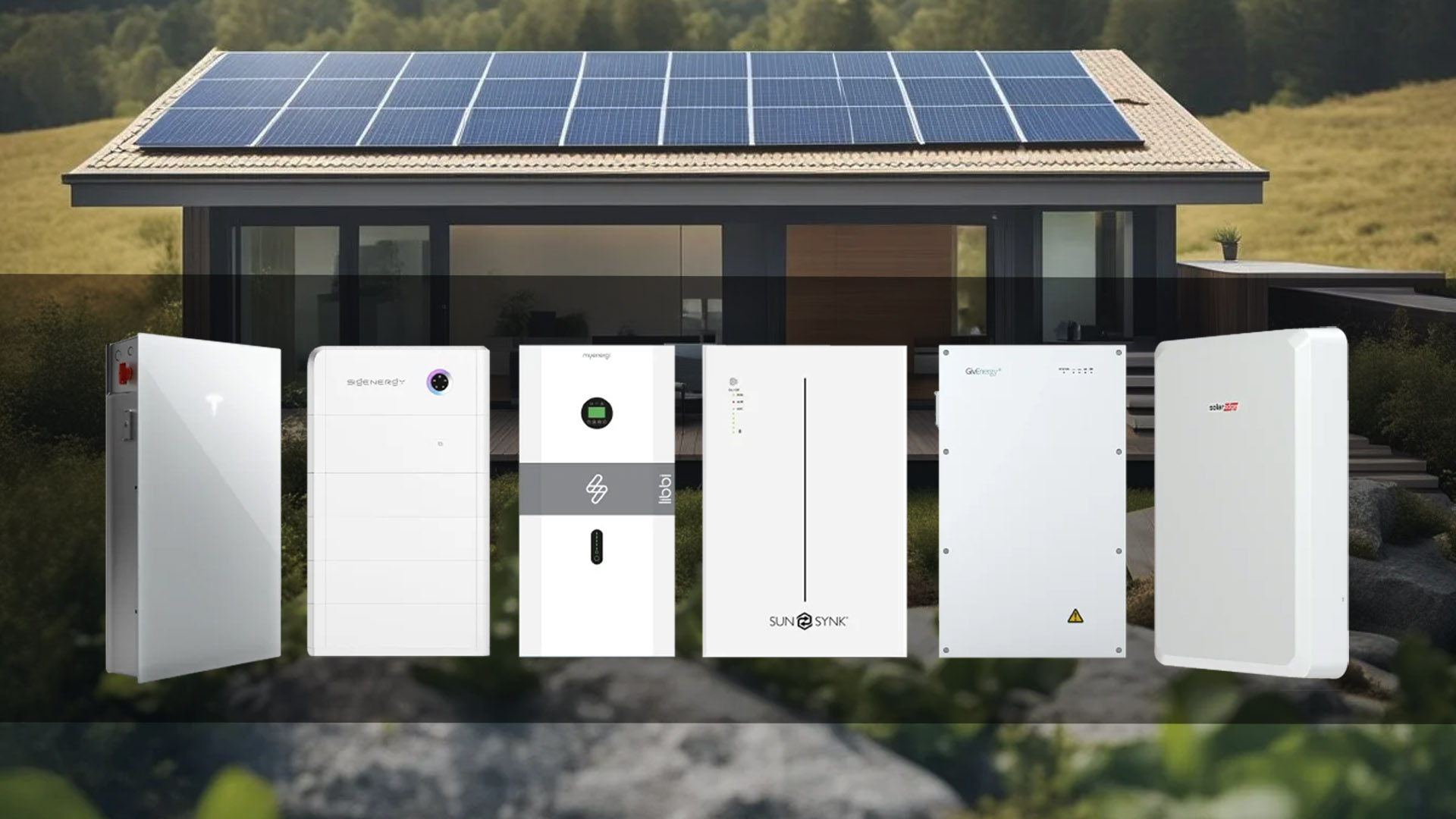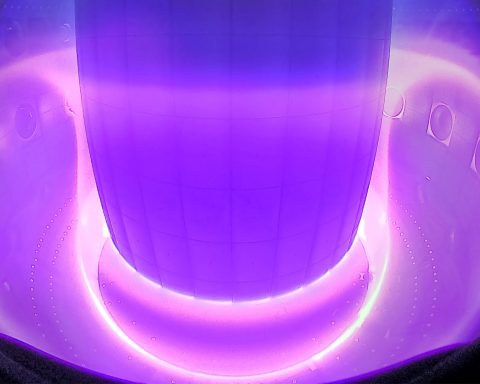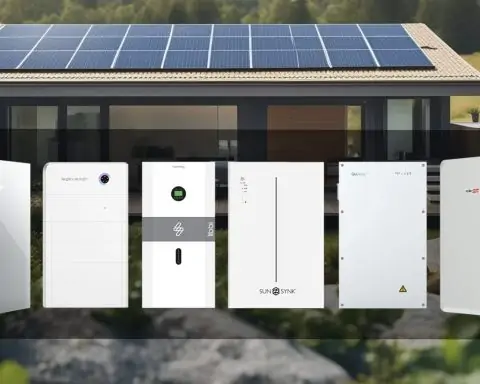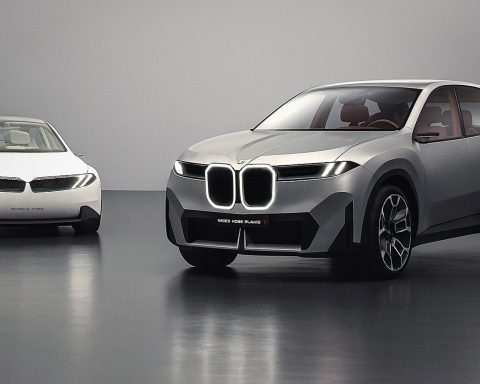- Top Home Batteries of 2025: Leading models like the Tesla Powerwall 3, Enphase IQ Battery 5P, FranklinWH aPower 2, Generac PWRcell 2, and BYD Battery Box offer 10–18 kWh usable capacity with high efficiencies (~90–98%) and extended warranties up to 15 years energysage.com, solarreviews.com. These systems provide reliable backup power and energy savings for homeowners.
- Lithium-Ion Dominance: Lithium-ion batteries (especially Lithium Iron Phosphate, LFP) dominate home solar storage in 2025 due to their long lifespan and deep discharge capability. Most lithium home batteries carry at least a 10-year warranty (often guaranteeing ~60–70% capacity retention), whereas traditional lead-acid batteries last ~5 years and allow only ~50% discharge without shortening life solarreviews.com.
- Smart, Integrated Systems: The latest batteries come with built-in inverters and smart controls. For example, the Powerwall 3 includes an integrated hybrid inverter for easy AC or DC coupling energysage.com, and Generac’s PWRcell integrates with smart thermostats for load management solarreviews.com. Users can monitor and control these batteries via mobile apps, participate in virtual power plants, and intelligently manage time-of-use rates.
- Costs & Incentives: A typical home solar battery system (around 10–15 kWh) costs ~$10,000–$20,000 installed in 2025 solarreviews.com. However, the 30% federal tax credit and various state/local rebates can cut effective costs significantly solarreviews.com. Lithium batteries cost more upfront than lead-acid (often 2× the price), but their higher efficiency and longer life provide better long-term value solarreviews.com.
- Choosing the Right Battery: The best solar battery depends on your needs. Consider your backup requirements (e.g. a 10 kWh battery can cover essential loads for a short outage, while ~30 kWh is needed to power an average home for 24 hours energysage.com), your power usage (high-demand appliances need batteries with strong continuous and peak output energysage.com), and your existing solar setup (AC-coupled batteries are ideal for retrofits and systems with microinverters energysage.com). Always compare capacity (kWh), power (kW), chemistry, warranty, and integration compatibility before buying.
What Are the Best Solar Batteries in 2025?
Home energy storage has exploded in 2025, with more brands and models than ever. Not long ago the market was dominated by a few names, but now even electronics companies like Anker and household names like Duracell have entered the fray energysage.com. Below we highlight 10 of the best-performing solar batteries for home use in 2025, along with their standout features (capacity, lifespan, efficiency, warranty, price, and smart capabilities):
1. Tesla Powerwall 3
Capacity & Power: 13.5 kWh usable capacity; 11.5 kW peak/continuous power output solarreviews.com.
Efficiency: ~97.5% round-trip efficiency for AC charging energysage.com – one of the highest in class.
Warranty: 10 years with at least 60% capacity retention (roughly 2,800 cycles) energysage.com, solarreviews.com.
Key Features: An integrated hybrid inverter means the Powerwall 3 can be AC- or DC-coupled, allowing flexible installation on new or existing solar systems energysage.com. It’s an all-in-one solution – sleek, wall-mountable, and weatherproof for indoor or outdoor use. The Tesla app enables smart control, time-of-use shifting, and monitoring. It’s also eligible for many virtual power plant programs.
Why It’s #1: The Powerwall 3 is the most popular home battery of 2025 solarreviews.com, praised for its reasonable price per kWh (around $950/kWh before install) energysage.com, brand reliability, and ease of installation. It’s a top choice for all-in-one performance, backed by Tesla’s proven track record in energy storage solarreviews.com.
2. Enphase IQ Battery 5P (Enphase Energy System)
Capacity & Modularity: ~5 kWh per IQ 5P module; often installed as a 15 kWh system (3 modules) for 15 kW power (stackable to larger capacities) solarreviews.com.
Efficiency: ~90%+ round-trip (AC-coupled).
Warranty: 15-year warranty or ~6,000 cycles – an industry-leading term solarreviews.com.
Key Features: Modular AC-coupled design – each unit has a microinverter, making it simple to expand and ideal for existing solar, especially if you already have Enphase microinverter panels. It offers a high continuous output (up to ~11.5 kW with three units) solarreviews.com and comes with Enphase’s robust Enlighten software for monitoring and smart scheduling. UL safety certifications are top-notch.
Why It Stands Out: Enphase’s battery earned a high ranking thanks to its flexible design, strong performance, and popularity among installers (over 70% of solar installers offer Enphase storage) solarreviews.com. The 15-year warranty reflects confidence in its longevity. It’s a great choice for homeowners seeking a reliable, long-lasting battery that integrates seamlessly with solar PV and doesn’t require a separate inverter.
3. Panasonic EverVolt Home Battery
Capacity: Modular system, typically 17.1–18 kWh with 4 battery modules (expandable) solarreviews.com.
Power: ~7.6 kW continuous output (per 18 kWh stack) solarreviews.com.
Warranty: 12 years or ~6,000 cycles at 60% capacity retention solarreviews.com – above the 10-year industry standard.
Key Features: Panasonic’s system is highly customizable – the EverVolt can be scaled by adding modules and includes an integrated EverVolt hybrid inverter. It supports both backup and self-consumption modes, and can be set up for grid outage protection with an automatic transfer. Quality and safety are in line with Panasonic’s reputation in electronics.
Buyer Caution: Panasonic announced in April 2025 that it will discontinue its solar and storage offerings (while honoring warranties) solarreviews.com. This means new EverVolt units may become harder to obtain. If you already have one or can find remaining stock, you’re getting a top-tier battery, but those without a contract in place should also consider other brands on this list for long-term support solarreviews.com.
4. Canadian Solar EP Cube
Capacity: ~9.9 kWh base, stackable to ~19.9 kWh (uses 3.3 kWh modules; commonly a 16.6 kWh setup with 5 modules) solarreviews.com.
Power: 7.6 kW continuous (with a full 5-module stack) solarreviews.com.
Warranty: 10 years or 6,000 cycles at 70% retained capacity solarreviews.com.
Key Features: Introduced in 2022, the EP Cube is an all-in-one hybrid battery system with a built-in inverter. It’s known for exceptional value – a low cost per kWh (around $550/kWh for the system) solarreviews.com while still delivering solid performance. The modular design and lightweight battery packs make installation and expansion easier. It’s also AC- or DC-couplable, giving flexibility in system design.
Why It Stands Out: Canadian Solar (a major panel manufacturer) brought its reputation for affordability and quality to storage. The EP Cube earned praise for great performance at a moderate price solarreviews.com, making advanced battery backup more accessible. It’s a top pick if you want a budget-friendly yet reliable battery solution from a bankable brand.
5. Anker SOLIX X1 Home Energy Storage
Capacity: ~5 kWh per module; typically installed as 10–15 kWh (2–3 modules) and scalable up to 30 kWh for larger homes solarreviews.com.
Power: 6 kW output (for a 3-module, 15 kWh system) solarreviews.com.
Warranty: 10 years (up to ~3,300 cycles) at 70% capacity solarreviews.com.
Key Features: The SOLIX X1 comes from consumer electronics giant Anker, known for batteries and chargers. It boasts a sleek, user-friendly design and a compact form factor. The system is modular and AC-coupled, allowing easy retrofit. It includes smart app integration for monitoring and can work in tandem with Anker’s fast EV chargers. The focus is on plug-and-play simplicity and affordability (it scored very high on value) solarreviews.com.
Why It Stands Out: In just its second year on the market, Anker’s battery has impressed installers and homeowners with its branding, design, and usability solarreviews.com. It offers one of the best $/kWh values among top batteries solarreviews.com, bringing down the cost of home backup. This is a great option if you want a reliable battery from a recognizable tech brand, and plan to expand storage over time.
6. PointGuard Home Battery (BatteryPack 8.0)
Capacity: 7.8 kWh per module (BatteryPack 8.0); highly stackable – up to ~390 kWh (!) with many modules, far beyond typical needs energysage.com. A common configuration is two modules for ~15.6 kWh solarreviews.com.
Power: ~4.4 kW per module; ~11.4 kW with two modules (scales with more packs) solarreviews.com.
Warranty: 10 years (~3,000+ cycles) at 70% capacity solarreviews.com.
Key Features: PointGuard (by parent company SigEnergy) is a newer entrant bringing innovative features. This DC-coupled battery is highly modular and scalable, allowing right-sizing of the system to your needs. It earned a perfect performance score in expert tests solarreviews.com – it’s efficient (~97% round-trip) and can directly DC-charge from solar. Future firmware updates are expected to enable vehicle-to-home (V2H) integration, meaning an EV could act as additional storage solarreviews.com.
Why It Stands Out: PointGuard is seen as a “future-proof” battery solution solarreviews.com. It’s great for tech-savvy users or those planning to expand their system or integrate an EV in the future. While the company is new (and thus carries some brand unknowns), early adopters and installers have been impressed by its performance and flexibility solarreviews.com. If you need a system that can expand almost without limit and want cutting-edge features, PointGuard delivers on scalability.
7. FranklinWH aPower 2
Capacity: 15 kWh per battery; can connect multiple units (up to 15 units for 225 kWh total) for whole-home backup energysage.com.
Power: 10 kW continuous output (doubled from the previous aPower model) solarreviews.com, energysage.com; 15 kW peak.
Efficiency: ~90% round-trip energysage.com (a bit lower than some competitors, but still solid).
Warranty: 15 years at 65% capacity – one of the longest warranties in the market energysage.com.
Key Features: The aPower 2 is an AC-coupled battery with a companion energy management device (the aGate). Together, they form the Franklin Whole Home system, which intelligently manages loads and solar integration. This battery is known for powering an entire home – it has strong surge capability to start heavy appliances and integrates with generators as a backup to your backup. It’s outdoor-rated and stackable up to substantial capacity for off-grid living.
Why It Stands Out: FranklinWH rapidly became one of the most-used battery brands in the U.S. solarreviews.com. The aPower 2 addresses prior shortcomings (it’s more powerful than version 1) solarreviews.com, and it offers a blend of high capacity and long warranty that few can match. It’s ideal for homeowners who want whole-home backup or off-grid potential, and who are willing to invest in a premium, robust system (with a price around $1,200 per kWh) energysage.com for peace of mind.
8. Qcells Q.HOME CORE
Capacity: 10 or 15 kWh usable (comes in a couple of size options; 15 kWh is common) solarreviews.com.
Power: 7.6 kW continuous output (matches typical PV inverter size) solarreviews.com.
Warranty: 12 years, ~6,000 cycles at 70% capacity solarreviews.com.
Key Features: Q.HOME CORE is the battery system from Qcells (Hanwha), a leading solar panel manufacturer. It’s part of a one-stop-shop solution – Qcells offers the panels, the hybrid inverter, the battery, and even a backup interface (Q.HOME Hub) all integrated solarreviews.com. The system is modular (the 15 kWh is achieved by stacking three 5 kWh packs internally) and is AC-coupled with an integrated inverter for easy installation. It also comes VPP-ready (virtual power plant) for future grid services, and the Hub allows smart home energy management.
Why It Stands Out: Homeowners who prefer a single brand ecosystem appreciate Qcells’ approach. You get a seamless integration of solar + storage, backed by Qcells’ large corporate support. It’s a solid mid-sized battery with a good warranty and the backing of a top panel brand – a reliable choice for standard home backup needs or energy shifting, especially if you pair it with Qcells panels solarreviews.com.
9. Generac PWRcell 2
Capacity: ~18 kWh usable with 6 modules (3 kWh each); smaller configurations possible (e.g. 9 or 12 kWh) and expandable by adding modules solarreviews.com.
Power: ~10 kW continuous output (with 6 modules) solarreviews.com; suitable for whole-home backup when paired with Generac’s automatic transfer switch.
Warranty: 10 years, ~2,500 cycles at 70% capacity solarreviews.com.
Key Features: The PWRcell 2 is Generac’s second-generation home battery, redesigned after lessons learned from the first gen. It’s a DC-coupled system that comes with a Generac inverter and integrates tightly with Generac’s ecosystem (solar inverters, generators, and even Ecobee smart thermostats for intelligent load shedding) solarreviews.com. It offers one of the higher power outputs in its class, enabling it to start and run heavy loads (e.g. well pumps, HVAC). The battery cabinet is typically installed indoors (garage or utility room) or in a protected outdoor enclosure.
Why It Stands Out: Generac is a familiar name in backup power (known for generators), and many homeowners trust the brand. PWRcell 2 addresses earlier reliability issues and provides a comprehensive backup solution – including options for smart management modules to prioritize circuits during outages solarreviews.com. While its cost per kWh is on the higher side solarreviews.com, it’s a compelling choice for those who want a high-power, integrated solar+storage+generator setup from a company known for keeping the lights on.
10. BYD Battery Box HVL
Capacity: ~16 kWh usable (four 4 kWh modules stacked); can scale up or down by adding/removing modules solarreviews.com.
Power: ~10.2 kW max output (when paired with a suitable inverter, e.g. 10 kW Fronius Symo hybrid) solarreviews.com.
Warranty: 10 years, ~2,500+ cycles at 60–70% capacity (standard for lithium-iron phosphate) solarreviews.com.
Key Features: BYD (Build Your Dreams) is one of the world’s largest battery and electric vehicle manufacturers. The Battery Box HVL is a high-voltage lithium iron phosphate (LFP) storage system. It’s unique for its inverter-agnostic design – it can work with multiple hybrid inverter brands (GoodWe, SMA, Fronius, etc.), giving installers and consumers flexibility solarreviews.com. The stackable module design simplifies transport and installation (no single heavy unit). With LFP chemistry, it’s very safe and has excellent cycle life.
Why It Stands Out: Globally, BYD has a proven record in battery technology, and the Battery Box is widely used in Europe, Asia, and Australia. In the U.S., it’s gaining traction for off-grid homes and large custom solar installations. Its value pricing (~$600–$700 per kWh for the hardware) solarreviews.com undercuts many competitors, making it attractive for budget-conscious projects that still demand a dependable solution. If you’re looking for a flexible, internationally proven battery (and especially if you favor LFP chemistry), BYD is a top contender.
Honorable Mentions: Villara VillaGrid 11.5 – an 11.5 kWh battery using Lithium-Titanate (LTO) chemistry with an unmatched 20-year warranty energysage.com and ultra-fast charging, though its higher cost and lower energy density kept it niche. SolaX Power T-BAT H 20 – a 18 kWh AC/DC-coupled battery with 95% efficiency and a 12-year warranty energysage.com, offering one of the largest single-battery capacities. Even battery icon Duracell now offers the Power Center (15 kWh unit) for home storage energysage.com, reflecting how mainstream solar batteries have become. And while not featured in the top 10, LG Energy Solution’s RESU Prime and Sonnen Eco are other well-known lithium-ion systems popular in certain markets for those seeking alternatives from established firms.
Types of Solar Batteries
Home solar batteries aren’t one-size-fits-all – they come in different types of technologies, each with pros and cons. The major categories in 2025 are lithium-ion batteries (the most prevalent), lead-acid batteries (an older technology, now less common for whole-home use), and flow batteries (an emerging option for long-duration storage). Here’s an overview of each type:
Lithium-Ion Batteries (Li-ion)
Overview: By far the dominant technology for home energy storage today. Lithium-ion batteries use lithium-based chemistries similar to those in electric vehicles and laptops electrek.co. They pack a lot of energy in a compact size and can efficiently charge and discharge for thousands of cycles. Home lithium batteries are deep-cycle, meaning they can discharge a large portion of their capacity (80–100% DoD) regularly without damage solarreviews.com. Most solar batteries in 2025 – including all the top 10 models above – are lithium-ion.
Key Chemistries:
- Lithium Iron Phosphate (LFP): The most popular subtype in 2025’s home batteries energysage.com. LFP offers excellent safety (very low fire risk), long cycle life, and thermal stability. It has slightly lower energy density than some others, meaning it’s a bit heavier/bulkier per kWh, but the trade-off is a longer lifespan and improved safety energysage.com. Many top batteries (e.g. Tesla Powerwall 3, Enphase IQ, BYD, FranklinWH) use LFP for its balance of performance and safety.
- Lithium Nickel Manganese Cobalt Oxide (NMC): A common Li-ion chemistry historically used in batteries like earlier LG Chem RESU units. NMC can pack more energy into a smaller size (higher energy density) energysage.com, but it’s a bit less stable and more prone to degradation and heating under stress. None of the top 2025 batteries rely on NMC alone energysage.com, as the industry has shifted toward LFP for residential storage. NMC batteries may have slightly shorter lifespans and require more cautious battery management to avoid thermal issues energysage.com.
- Lithium Titanium Oxide (LTO): A newer, premium chemistry used in a few high-end batteries like the Villara VillaGrid. LTO batteries exhibit extraordinary longevity and fast charging – 15,000+ cycle potential – and operate in a wide temperature range. They also have virtually no risk of thermal runaway. However, LTO is the least energy-dense (batteries are larger/heavier per kWh) and very costly up front energysage.com. LTO batteries can last 20+ years with minimal degradation (as seen by VillaGrid’s 20-year warranty) energysage.com, making them attractive for those who prioritize lifespan over cost.
Pros of Lithium-Ion: High energy density (stores a lot in a small space), high efficiency (~90–98% round-trip) solarreviews.com, long lifespan (10–15+ years) solarreviews.com, low self-discharge, and little to no maintenance. Most can be wall-mounted and placed indoors or outdoors (with proper enclosures). They are also dropping in cost thanks to mass production for EVs electrek.co.
Cons: Higher upfront cost compared to older battery types solarreviews.com. There is a non-zero risk of thermal runaway fire in rare cases of damage or manufacturing defect (especially with NMC chemistry), though modern units have multiple safety features and the incidence is extremely low. Also, while vastly improved, lithium batteries do slowly degrade with each cycle, typically retaining ~70–80% of their initial capacity after the warrantied cycles. Eventually (often after 10–15+ years) they will need replacement, unlike some alternative chemistries that can last longer.
Lead-Acid Batteries
Overview: Lead-acid batteries have been used for decades in off-grid solar systems and are the same chemistry as car starter batteries (but in deep-cycle form). They come in flooded (wet cell) or sealed (AGM, gel) varieties. In 2025, lead-acid is largely phased out for new residential solar installations in favor of lithium, except in certain off-grid or budget scenarios. However, some homeowners with existing lead-acid battery banks or specific off-grid needs still use them.
Pros: Low upfront cost – lead-acid batteries are much cheaper per kWh to buy initially (often half the price of lithium or less) solarreviews.com. For instance, an off-grid 10 kWh AGM battery bank might cost a few thousand dollars (though it may require more frequent replacement). Lead-acid is also a proven, simple technology that doesn’t require sophisticated battery management electronics. In off-grid cabins, etc., flooded lead-acid can work reliably if maintained (and can tolerate very high surge currents for short periods).
Cons: Shorter lifespan and lower usable capacity. Even “deep cycle” lead-acid batteries (like AGM or golf-cart batteries) typically only last 3–5 years in daily use, with maybe 500–1,500 full cycles before significant degradation large-battery.com. They also should not be discharged beyond ~50% regularly – doing so dramatically shortens life solarreviews.com. This means a “10 kWh” lead-acid bank really gives you about 5 kWh usable per cycle. Lead batteries are also bulky and heavy (much lower energy density – they take up 3–4× more space per kWh than lithium) relionbattery.com, which is problematic for suburban home installations with limited space solarreviews.com. Maintenance can be an issue too: flooded cells need periodic water topping and equalization charges, and all lead-acid batteries must be stored in ventilated areas to avoid hydrogen gas buildup.
Use Cases: Due to these limitations, lead-acid is now mostly seen in niche applications or as a stop-gap: for example, a remote off-grid home might use a large inexpensive lead-acid bank initially and plan to replace it every few years. But for grid-tied backup with solar, most homeowners find lithium-ion’s longer life and zero maintenance worth the higher price. Overall, if you’re seeking a whole-home battery in 2025, lithium-ion will almost certainly be the recommendation over lead-acid unless upfront cost is the overriding factor.
Flow Batteries
Overview: Flow batteries are an emerging technology for energy storage that could play a bigger role in the future. Instead of storing energy in solid electrodes (like lithium or lead batteries), flow batteries store energy in liquid electrolytes held in tanks. One common type is the Vanadium Redox Flow Battery (VRFB). When charging or discharging, the electrolytes are pumped through a cell stack where ion exchange occurs, but the liquids themselves store the energy.
Pros: Exceptional longevity and no capacity fade. Flow batteries can often cycle tens of thousands of times with virtually no degradation in storage capacity over 20–30 years electrek.co. This is a game-changer for lifespan – a flow battery might last two or three decades whereas lithium needs replacement after ~10-15 years. They also pose minimal fire risk – no risk of thermal runaway since the electrolyte is usually water-based and non-flammable electrek.co. Flow batteries can be left at any state of charge without damage and can be completely discharged without hurting longevity. Additionally, you can scale energy capacity and power somewhat independently (bigger tanks for more kWh, or bigger cell stack for more kW) electrek.co.
Cons: Lower energy density and higher cost (for now). Flow batteries are large – to get, say, 20 kWh of storage, you need sizable tanks, pumps, and plumbing. A comparable flow battery system will take up much more space (often a full closet or shed) than a wall-mounted lithium unit electrek.co. They also have lower round-trip efficiency (~70–80%), because pumping fluid and the electrochemical process introduce more losses electrek.co. Currently, flow batteries are expensive due to low production volume and the use of vanadium (a costly metal) – estimates range from $500–$900 per kWh in 2025 electrek.co, which can rival or exceed lithium costs once installation is included. Maintenance is another factor: pumps and membranes may need occasional service, though not too frequently.
Home Use in 2025: A few companies (e.g., StorEn Tech, Voltstack) are piloting residential-sized vanadium flow batteries. For example, one model offers ~30 kWh of storage and 5 kW output with an expected 20-year life electrek.co. Such a battery could power a home for longer stretches (great for off-grid or multi-day outages) and not degrade over time. However, these are still early-stage products – bulky and suited more for ground installation or in a garage/shed. Bottom Line: If you need very long-duration storage and plan to stay in your home for decades, a flow battery is intriguing. But for most homeowners, lithium-ion is a more practical choice today, with flow batteries hopefully becoming more compact and affordable in the coming years.
(Other battery types: There are other chemistries like sodium-ion, nickel-iron, or zinc-based batteries under development, but they are either not yet widely available for homes or remain niche. For instance, sodium-ion batteries promise lower cost and better cold-weather performance but were only emerging from labs to pilot products by 2025. As of now, lithium-ion and the alternatives above cover the vast majority of home storage options.)*
How We Developed Our Best Solar Battery Ranking
Picking the “best” solar batteries isn’t simple – it requires evaluating a mix of technical specs, real-world performance, cost, and reliability. Our rankings and recommendations are based on a comprehensive review of dozens of battery models available in 2025, using criteria that matter most to homeowners. Here are the key factors we considered:
- Performance (Capacity, Power & Efficiency): We examine each battery’s usable capacity (kWh of energy storage) and how that can scale for whole-home use, as well as its power output in both continuous and peak terms (kW). A great battery should store enough energy for your needs and deliver sufficient power to run your essential appliances. We also compare round-trip efficiency – the percentage of energy that can be retrieved from what’s stored. The best batteries now exceed 95% efficiency, meaning minimal energy loss in conversion energysage.com. We factor in energy density (does the battery store a lot without taking up too much space?) and flexibility (can it be expanded with modules, and can it accept solar power directly in DC form?). A higher capacity and power, combined with high efficiency, scored better in our evaluation. For example, batteries like the Powerwall 3 and IQ 5P earned high marks for strong power output relative to their size solarreviews.com.
- Cost & Value: We compare the cost per kWh of storage for each battery system, including any additional equipment needed. Rather than just looking at sticker price, we considered the value proposition – does this battery give a good amount of storage and features for its price? Some batteries that seem expensive can be worth it if they offer exceptional performance or longevity, while lower-cost batteries that skimp on output or cycles scored lower. As a benchmark, the industry average cost (before installation) is about $850 per kWh for batteries solarreviews.com. Batteries like the Canadian Solar EP Cube stood out with a very low cost per kWh (around $550/kWh) without major compromises solarreviews.com, earning a high value score. We also consider that DC-coupled batteries might need a separate hybrid inverter cost added, whereas AC batteries include an inverter solarreviews.com.
- Longevity & Warranty: A battery is only as good as it lasts. We heavily weight the warranty terms – both the length (years) and the promised cycle life or throughput. The standard in 2025 is a 10-year warranty, but several leaders offer 12 or even 15 years solarreviews.com. We also check the end-of-warranty capacity (most guarantee 60–70% of original capacity remains) and any cycle count or energy throughput limits. A higher guaranteed cycle count (e.g. 6,000+ cycles) indicates a battery built for daily use. For instance, Enphase’s 15-year or 6,000 cycle warranty and FranklinWH’s 15-year warranty gave them an edge solarreviews.com. We also accounted for battery chemistry’s inherent cycle life – LFP batteries tend to last longer than NMC, and LTO longest of all – when judging longevity. All else equal, batteries with longer and more comprehensive warranties ranked higher, as they indicate both durability and manufacturer confidence.
- Safety: Safety is crucial. We ensure the batteries we recommend carry necessary safety certifications (UL 9540/1973, UN 38.3, etc.) solarreviews.com. We considered the inherent safety of the chemistry – LFP batteries are very stable and resist overheating, whereas NMC require more stringent battery management to ensure safety energysage.com. Any history of recalls or thermal incidents would count against a battery (thankfully rare in stationary storage). Companies that emphasize safety features (thermal monitoring, fire-resistant casing, automatic disconnects) scored better. For example, all top batteries have sophisticated battery management systems and have passed rigorous abuse testing. Flow batteries also get high marks on safety due to their non-flammable electrolytes, though their other factors kept them out of top rankings for now. Overall, we only considered models that meet high safety standards for home installation.
- Installation & Integration: We looked at how easy or flexible each battery is to install and integrate into a home. This includes whether it’s AC-coupled or DC-coupled – AC batteries (like Tesla and Enphase) can be added to almost any existing solar setup easily energysage.com, which is a big plus for retrofit installations. DC-coupled batteries (like Generac PWRcell or EP Cube) can be more efficient in new installs but are harder to add to old systems – we took that into account. We also considered physical installation: is the unit modular (can be carried in pieces) or is it a heavy single unit? Can it be wall-mounted or does it require floor space? What are its temperature and outdoor ratings? Batteries that are all-in-one units with minimal extra components and those with options for both indoor and outdoor installs offer more flexibility to homeowners, and thus ranked higher solarreviews.com, energysage.com. We also gave points to systems with smart integration features – e.g., a battery that comes with a built-in critical loads panel or can integrate with home automation or a generator. The more the system can seamlessly work with a home’s existing electrical setup, the better.
- Brand Track Record & Support: Lastly, we factor in the manufacturer’s reputation, financial strength, and customer support, as these affect the long-term value to the homeowner solarreviews.com. A battery isn’t useful if the company behind it goes out of business and can’t honor the warranty or provide service. We prefer companies with a proven track record or, if newer, clear indications of stability (e.g., backing by a larger parent company or strong financials). This criterion favored established names like Tesla, BYD, Qcells, and Generac, but we also acknowledged newcomers making waves (like FranklinWH and PointGuard) especially if they are gaining industry acceptance. We looked at customer reviews and installer feedback as well – for example, the percentage of installers willing to work with a given brand solarreviews.com tells us if the technology is trusted in the field. A brand that is widely adopted and recommended by professionals is a good sign for consumers. Conversely, any brand with consistent negative reviews or support issues would be rated lower.
Each of these factors was considered to arrive at our ranking of the best solar batteries. In essence, the top batteries of 2025 are those that excel across multiple categories – they offer strong performance and capacity for the price, have long warranties and safe chemistries, are easy to integrate into your home, and come from companies that will stand by the product. Our methodology aims to ensure you get not just a good battery, but peace of mind that it will perform well for many years solarreviews.com.
How to Choose the Best Solar Battery for Your Home
Every home is different, and the ideal solar battery for one household might not be the best for another. Choosing the right battery comes down to evaluating your own energy needs, budget, and priorities. Below is a buyer’s guide to help you decide which solar battery is best for your situation, based on key factors:
- Assess Your Power Needs and Usage: Start by determining what you want to back up and for how long. Do you just need to keep a few critical devices (fridge, lights, Wi-Fi) running during occasional outages, or do you aim to power most of your home regularly at night? If it’s the former, a smaller battery (~10 kWh) may suffice for a short outage energysage.com. If it’s the latter – for example, you want to cover an entire home through a 12-hour night – you’ll likely need a much larger system (20–30+ kWh, or multiple batteries). Backup duration is key: the average American home uses about 30 kWh per day, so a ~30 kWh battery bank is needed to go a full day off-grid energysage.com. Also consider power output: a battery with a higher continuous wattage (5–10 kW) can run more appliances at once. If you have high-surge equipment (well pump, AC, sump pump), look at the battery’s peak power rating – you’ll want a battery that can handle those short bursts of high demand energysage.com. Make a list of must-power items and their wattages to guide your choice.
- Decide on Backup vs. Daily Cycle Use: Some people install batteries mainly for emergency backup, others for daily self-consumption (using solar energy at night, arbitraging time-of-use rates). Your goal affects the type of battery you need. For backup-only use, you might prioritize high power output (to seamlessly take over during an outage) and possibly a slightly lower cost, even if cycle life is modest, since you won’t cycle it daily. For daily use, you want a battery with high cycle life (look for 5,000+ cycles warranty) and high efficiency, so you maximize savings. Lithium-ion batteries (LFP in particular) are well-suited to daily cycling with 90%+ depth of discharge, whereas lead-acid would wear out quickly in that role solarreviews.com. If you anticipate cycling your battery every day (for financial savings or because you’re off-grid), spend a bit more for a robust system designed for it (like those with 10+ year, 6,000 cycle warranties). If it’s just for the occasional outage, a smaller or slightly lower-cycle battery could be sufficient (you’ll use it less often, so it will last many years).
- Evaluate Your Solar Setup and Inverter Compatibility: Do you already have solar panels installed? If yes, the type of solar inverter you have can dictate what batteries make sense. For homes with existing solar: an AC-coupled battery (one with its own built-in inverter, like Tesla or Enphase) is usually the easiest, most cost-effective addition energysage.com. AC batteries can connect to your main electrical panel without reconfiguring your PV system. This is especially true if your solar uses microinverters (Enphase, SunPower, etc.) or power optimizers – those setups require AC batteries, since DC-coupled batteries can’t interface with microinverters energysage.com. On the other hand, if you are installing a new solar-plus-battery system from scratch, you might opt for a DC-coupled battery with a hybrid inverter (like Generac PWRcell, SolarEdge Energy Bank, or EP Cube). DC coupling is a bit more efficient (only one inversion step) and can be slightly cheaper for new installs, but it’s impractical to retrofit on an existing system with a standard inverter energysage.com. Also consider shading and panel stringing: if your roof has shade and you use microinverters for panel-level optimization, you’ll lean toward AC batteries (since those systems can’t easily accommodate DC batteries) energysage.com. In summary, check what inverter(s) you have and choose a battery type that’s compatible. Consult with a solar installer if unsure – they can tell you which batteries play nicely with your current system or if additional equipment (like a new inverter or gateway) is needed.
- Calculate Your Budget (and Factor in Incentives): Determine how much you’re willing and able to spend on a battery system. Prices for a home battery (including installation) in 2025 typically range from ~$10,000 on the low end (for a smaller battery or after incentives) to $20,000 or more for a large or premium system solarreviews.com. If you need multiple batteries for whole-home backup, costs can approach $30k. However, remember that the 30% federal tax credit applies to energy storage systems (when charged by solar), effectively giving a big discount on the price solarreviews.com. Many states and utilities also have rebates or programs (for example, California’s Self-Generation Incentive or various VPP programs) that can further reduce cost. When choosing, consider the cost per kWh of usable capacity as a metric for value. Also include any additional equipment (gateway, new inverter, etc.) in your cost calculations. If two batteries meet your needs, the one that’s a better deal financially (from a reputable brand) is likely the smarter choice. That said, be cautious about too-good-to-be-true cheap batteries from unknown brands – ensure they have proper certifications and support. It might be worth paying a bit more for a system with a longer warranty or a strong company behind it, as that can save money in the long run by avoiding early replacements.
- Consider Space and Installation Constraints: Where will the battery go? Check if you have a suitable installation location. Most home batteries are about the size of a small refrigerator or cabinet, and many can be wall-mounted. If you have limited floor space in your garage or utility room, look at wall-mountable units like the Powerwall or Enphase. If wall-mounting, ensure your wall can handle the weight (batteries can weigh 200–300+ lbs; usually studs and possibly a concrete wall/floor support are needed). For outdoor installation, pick a battery that is outdoor-rated (look for an IP (ingress protection) rating, e.g. IP65 means dust-tight and rain-safe). Many batteries are outdoor compatible, but some inverters or control panels might need to be indoors – verify with your installer. Also consider climate: if you live in a very cold or hot area, ensure the battery can operate in your temperature range (lithium batteries often specify 0°C to 40°C for charging; some have heaters or coolers integrated). Enclosure and aesthetics might matter too – do you need a slim unit to fit in a particular spot or a certain color to appease HOA/partner? Note that LFP batteries tend to be mid-sized, NMC slightly more compact, and LTO batteries the bulkiest per kWh energysage.com. If space is tight, a higher energy density battery (like those using NMC or high-density LFP) might be preferable. Also, check if the battery requires clearances (most need some space around for ventilation). Planning out the installation spot in advance will help narrow your options.
- Check Integration with Home Circuits (Whole Home vs. Partial Backup): Decide if you want to back up your entire home or just critical loads. Many battery systems cannot power a whole home’s heavy loads with a single unit, so installers often set up a critical loads subpanel – only specific circuits (fridge, outlets, etc.) are backed up by the battery. If your goal is whole-home backup, you may need multiple batteries or a battery that can be “stacked” to higher power output. Some brands (Tesla, Generac, Franklin) allow multiple units to work together for whole-home backup. Others might max out at one or two units. Be sure the battery you choose can handle the load or can be augmented if you intend to run everything. Additionally, if you have existing generator integration or plan one, consider batteries that integrate with generators – for example, some systems can automatically start a generator when the battery depletes, or charge the battery from the generator. If you want that functionality, look for a battery with generator integration capabilities solarreviews.com or an external transfer switch setup. On the flip side, if you’re in an area with time-of-use electricity rates, a smaller battery might be sufficient just to shave peak evening usage – you might not need to back up everything, just discharge 5–10 kWh daily to offset expensive grid power. In that case, a battery like Enphase (which is easily scalable down or up) might fit well. Tailor your choice to how you intend to use the stored energy.
- Review Warranties and Support: As mentioned, warranties are a critical part of battery shopping. Compare the warranty periods and what they cover. A 10-year warranty is common, but the difference is in the details: Does the warranty specify a maximum number of cycles or energy throughput? What capacity will it retain at the end? Ensure you’re comfortable with those terms. Also, consider the manufacturer’s support network – do they have local service teams or a good hotline if something goes wrong? Since a battery is a long-term investment, you want to be confident that you can get service or a replacement if needed in year 8 or 9. Check reviews for any red flags on warranty claim experiences. If two products are similar, the one from a company with a better reputation for honoring warranties might be the safer bet. Remember that some newer companies (even if their tech is great) may have unknown long-term support, whereas an established company might give more peace of mind. Also note if the installer offers an additional workmanship warranty on the battery installation. Don’t hesitate to ask installers about their experience with a product – if they report that one battery has had a lot of issues or failures, take that into account.
- Look for Smart Features and Future-readiness: Many of the best batteries come with extra features that can add value depending on your interests. For example, does the battery have a good mobile app or web portal for monitoring? Most do, but interfaces vary – Tesla’s app is very polished, while some lesser-known brands might be more basic. If you want to participate in a utility program or VPP (Virtual Power Plant), check if the battery is eligible (Tesla, Enphase, Sunrun/Sonnen and others have programs in certain areas where you can get paid to let the utility use some of your battery during peak events). If you have or plan to get an EV, you might consider whether the battery system could integrate with it down the line – a few systems are hinting at EV integration (for example, PointGuard says it aims to use EVs for extra storage in the future) solarreviews.com, and Ford/GM are enabling certain EVs to power homes. While using an EV battery for home backup is still separate from a stationary battery, a system that can coordinate with other energy devices in your home is a plus. Additionally, some batteries come with advanced load management (e.g., the ability to prioritize certain circuits or to work with smart thermostats or appliances to shed load). If you’re interested in a truly smart home energy system, look for batteries that advertise integrations with other smart home products or home automation platforms. These features might tip the balance if you’re comparing two otherwise similar batteries.
- Consult a Professional Installer: Lastly, while doing your own research is valuable (and encouraged!), it’s wise to get quotes and advice from certified solar battery installers. They can perform a load analysis on your home, identify any electrical upgrade needs, and recommend battery options that fit your specific situation. Often, installers have experience with a handful of brands and can give insight into which ones have proven reliable and which ones might be troublesome. They’ll also ensure whatever you choose is compatible with code requirements and permitting. Treat the installer as a partner in the decision – a good installer will not only sell you a battery but also help you optimize the system design for your goals. And by comparing a few quotes, you can gauge if one is pushing a particular product for their benefit versus giving unbiased advice. In the end, the best battery for your home will be the one that checks all your boxes: adequate capacity and power, fits your budget, safe and reliable, and installed by someone you trust.
By carefully considering the factors above, you’ll be well on your way to choosing a home solar battery that provides the backup power and energy savings you need. Whether it’s one of the top 10 models we highlighted or another system that suits a unique need, the right battery will offer you greater energy independence, peace of mind during outages, and the potential to maximize your solar investment for years to come. energysage.com












